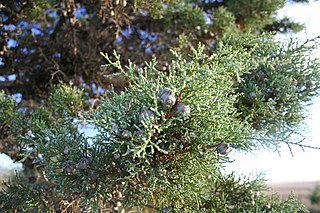
The International Union for Conservation of Nature (IUCN) Red List of Threatened Species, founded in 1964, is the world's most comprehensive inventory of the global conservation status of biological species. It uses a set of precise criteria to evaluate the extinction risk of thousands of species and subspecies. These criteria are relevant to all species and all regions of the world. With its strong scientific base, the IUCN Red List is recognized as the most authoritative guide to the status of biological diversity. A series of Regional Red Lists are produced by countries or organizations, which assess the risk of extinction to species within a political management unit.

Cypress is a common name for various coniferous trees or shrubs of northern temperate regions that belong to the family Cupressaceae. The word cypress is derived from Old French cipres, which was imported from Latin cypressus, the latinisation of the Greek κυπάρισσος (kyparissos).
Juniperus indica, the black juniper, is a juniper native to high-altitude climates in the Himalaya, occurring in Pakistan, India, Nepal, Bhutan and China.

The conservation status of a group of organisms indicates whether the group still exists and how likely the group is to become extinct in the near future. Many factors are taken into account when assessing conservation status: not simply the number of individuals remaining, but the overall increase or decrease in the population over time, breeding success rates, and known threats. Various systems of conservation status exist and are in use at international, multi-country, national and local levels as well as for consumer use.

Guibourtia is a flowering plant genus in the family Fabaceae, also known by the common names as Rhodesian copalwood, African rosewood, amazique, bubinga, kevazingo and ovangkol.

Rosewood refers to any of a number of richly hued timbers, often brownish with darker veining, but found in many different hues.

An IUCN Red List Critically Endangered (CR) species is one that has been categorized by the International Union for Conservation of Nature as facing an extremely high risk of extinction in the wild. As of 2021, of the 120,372 species currently tracked by the IUCN, there are 6,811 species that are considered to be Critically Endangered.
Erythrina schliebenii is a species of legume in the family Fabaceae. It is found only in Tanzania. The species is named for German collector and botanist Hans-Joachim Schlieben.
Guibourtia ehie is an evergreen tree of the genus Guibourtia in the family Fabaceae, also known by the common names amazique, amazoué, hyedua, black hyedua, mozambique, ovangkol and shedua.
Guibourtia sousae is a species of plant in the family Fabaceae. It is found only in Mozambique.
Millettia schliebenii is a species of legume in the family Fabaceae. It is found only in Tanzania.
Balthasaria schliebenii is a species of plant in the Pentaphylacaceae family. It is found in the Democratic Republic of the Congo, Rwanda, and Tanzania.

Helicia is a genus of 110 species of trees and shrubs, constituting part of the plant family Proteaceae. They grow naturally in rainforests throughout tropical South and Southeast Asia, including India, Sri Lanka, Indochina, Peninsular Malaysia to New Guinea and as far south as New South Wales.
Premna schliebenii is a species of plant in the family Lamiaceae. It is found in Mozambique and Tanzania.
Sterculia schliebenii is a species of plant in the family Malvaceae. It is found in Kenya, Mozambique, and Tanzania.
Vangueria schliebenii is a species of flowering plant in the family Rubiaceae. It is endemic to Tanzania.
Tricalysia schliebenii is a species of plant in the family Rubiaceae. It is endemic to Tanzania.
Sphyrarhynchus is a monotypic genus of flowering plants from the orchid family, Orchidaceae. The sole species is Sphyrarhynchus schliebenii, endemic to Tanzania.

Angraecum podochiloides is a species of comet orchid that can be found in Cameroon, the Democratic Republic of the Congo, Côte d'Ivoire, Equatorial Guinea, Gabon, Ghana, Liberia and Nigeria. It can be found in dense lowland forests on Gilbertiodendron dewevrei, and in humid forests at higher elevations or low montane forests. It is an epiphyte on Dialium corbisieri or in periodically-flooded marshes with Guibourtia.
Guibourtia tessmannii is a species of legume in the family Fabaceae. It is a medium to large-sized tree and is native to Cameroon, Gabon and Equatorial Guinea. The timber has an attractive appearance and has many uses, and the bark is used in traditional medicine.







